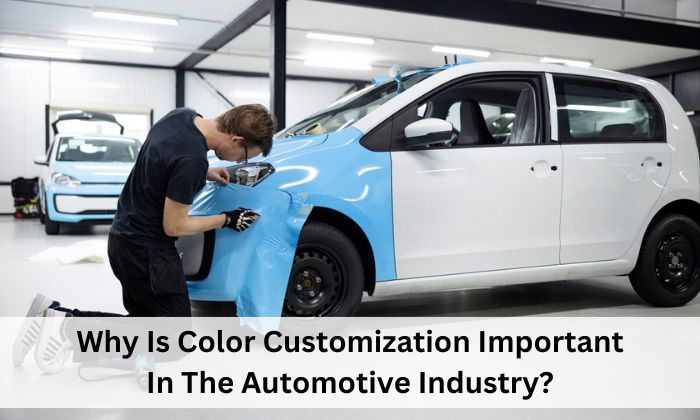Color personalization affects customer preferences and brand identification in the car business. Offering a variety of colors is crucial as cars become manifestations of identity. This article examines the psychological influence of car color customization, brand awareness, and customer preferences. Understanding color’s powerful impact may help manufacturers boost consumer happiness, brand loyalty, and competitiveness in the ever-changing automobile industry.
| Importance | Description |
| Customer Loyalty | Retains customers and fosters repeat business. |
| Brand Recognition | Builds brand awareness and establishes a distinct identity. |
| Market Analysis | Identifies trends and opportunities for strategic growth. |
| Product Development | Drives innovation and enhances product offerings. |
| Cost Management | Optimizes expenses and improves profitability. |
Psychological Impact Of Color
The psychological impact of colors affects human emotions and perceptions. Color selections may connect with customers in many sectors, including automotive, so understanding this influence is vital. Researchers say colors might provoke certain emotions and connections. For instance, red symbolizes energy and enthusiasm, whereas blue represents trust and dependability. Automakers may use these psychological impacts to pick colors that create desirable feelings in purchasers.
Color psychology influences customer choices in the car sector. The University of Loyola, Chicago, discovered that automobile color strongly affects customer perceptions of quality and performance. Bright colors may be energetic or young, while neutral tones are elegant. Understanding these correlations helps manufacturers match color selections to target consumer preferences and lifestyles.
Color psychology includes cultural and socioeconomic implications beyond individual preferences. Color interpretations differ by culture, affecting vehicle choices. Some cultures link white with purity and cleanliness, whereas others identify it with grief and funerals. Global automakers must consider these cultural differences while choosing color palettes.
Recently, the car industry has adopted more expressive and daring color choices. Black, white, and silver remain the rule, but shoppers choose bolder colors to make a statement. Buyers may customize their cars to express their personalities.
Automakers use numerous marketing and product methods to leverage the psychological influence of color. To thrill and grab attention, ads use bright colors. Limited edition models with unique color choices appeal to collectors and enthusiasts, tapping into the emotional connection between people and their cars.
Brand Identity And Recognition
Automakers need a brand identity to stand out in a competitive market and build customer loyalty. Brand identification and recognition depend on colors. Signature colors are typically associated with iconic vehicle manufacturers. Ferrari is known for its red, whereas BMW is famous for its blue and white.
Brand identification and awareness are strengthened by color consistency throughout marketing materials, product packaging, and vehicle design. Consumers instantly link a hue with a brand, boosting brand loyalty and trust.
Additionally, colors may represent brand values and traits. For instance, vivid colors exude a brand’s creativity and adventure. Muted tones may convey elegance and luxury, supporting a brand’s premium posture.
Colors shape brand identity and differentiate brands. Brands must provide something distinctive in a competitive market with many options. Automakers may differentiate themselves by using unique colors and designs.
Personalization And Consumer Preferences
Due to customer preferences, the automobile sector is moving toward individualized goods and experiences. Today’s buyers want cars that represent their tastes and lifestyle. Automakers must provide a broad range of color customization choices to satisfy various consumer preferences and improve customer satisfaction.
Customization lets customers design a car that matches their tastes. Consumers may pick colors that match their personality and lifestyle, from bright to muted. Personalization creates an emotional connection between people and their cars, increasing brand loyalty and pleasure.
In addition to exterior paint, upholstery, and trim may be customized in hue. Choose complementing colors and materials to create a coherent and unique home that meets your interests. This personalization improves driving and establishes the car as an extension of the owner’s personality.
Automakers provide significant color customization throughout their product ranges to meet this rising desire for individuality. From entry-level models to luxury automobiles, manufacturers offer a broad selection of color options to ensure every customer gets the right fit.
Market Demand And Competitive Edge
Automotive consumers increasingly want customizable features like color selections. Today’s shoppers want cars that represent their style and tastes. Thus, automakers with broad color customization have a market advantage.
Social media and digital platforms have increased demand for unique and customized items. Color personalization lets consumers express themselves and stand out. Automakers may satisfy various consumer interests and brand loyalty by providing color variations.
In a competitive market, color personalization may set manufacturers apart. Customization helps firms stand out in a market with little product uniqueness. Color customization is a profitable possibility for automakers since consumers are ready to pay more for individualized items.
Technological Advancements In Color Customization
Technology has transformed car color personalization, providing unparalleled accuracy and versatility. Digital design tools and improved paint technology have increased manufacturers’ color customization possibilities and inventiveness.
Color customization has advanced with digital design tools and virtual configurators. These technologies let users explore color combinations in real-time, creating an immersive experience. Virtual configurators let buyers make educated judgments by letting them try different colors and configure their automobiles to their requirements.
Consumers have additional color selections because of paint technology. High-quality paints with excellent durability and weather resistance keep bespoke colors vibrant and intact. Metallics, pearls, and matte paints offer buyers additional car customization options.
Automakers also use sophisticated color-matching systems to maintain color uniformity across components and materials. Computerized color-matching systems analyze color samples and create bespoke paint mixes to match color codes or client preferences. Custom-colored automobiles satisfy the highest quality requirements and surpass client expectations with this accuracy.
Environmental Considerations
In an age of environmental consciousness, manufacturers are under pressure to use more sustainable color customization methods. Traditional painting uses volatile organic compounds (VOCs) and other toxic substances that damage the environment and humans. Thus, manufacturers are investigating eco-friendly paint and sustainable procedures to reduce environmental effects.
Water-based paints are a significant advance in eco-friendly color customization. Water-based paints are safer for the environment and humans than solvent-based paints since they contain less VOCs and toxic compounds. Manufacturing water-based paints use less energy and resources, decreasing their carbon footprint and environmental effects.
Automakers invest in alternate paint materials and application techniques to lessen their environmental impact further. Bio-based paints, manufactured from plant oils and resins, are more sustainable than petroleum-based paints. Powder coating uses dry powder and heat to cure, uses no solvents, and produces little waste.
Conclusion
Innovation and adaptability to changing customer tastes and technology will define automobile color customization in the future. Automakers must foresee trends and stay ahead to compete as customer demand for individualized goods develops.
Integrating AR and VR technology with color customization is a significant trend. These immersive and interactive technologies let buyers view and personalize their automobiles in unprecedented detail. AR and VR technologies let users try multiple colors, materials, and finishes in real time, increasing customization and engagement.
FAQs
Why Is Color Customization Necessary In The Automotive Industry?
Customers may customize the colors of their cars to fit their personalities. Establishing brand identification and familiarity helps automakers stand out in a competitive market.
How Does Color Choice Impact Consumer Perception?
Colors affect how people feel about a car’s quality, performance, and brand. Understanding color psychology helps automakers match customer tastes and market trends.
Are There Environmental Considerations In Color Customization?
Yes, automakers are using eco-friendly paint and sustainable procedures to reduce their environmental effect. We use water-based paints, alternative materials, and efficient painting procedures to decrease waste and carbon emissions in color customization.

